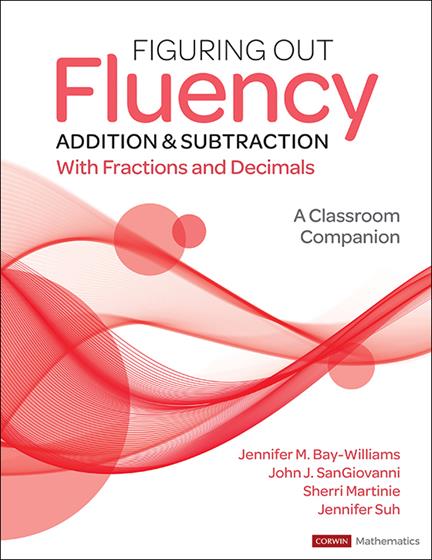Hands-on, Practical Guidance for Educators
From math,
literacy, science, equity, multilingual learners, and SEL, to assessment, school counseling,
and education leadership, our books are research-based and authored by experts
on topics most relevant to what educators are facing today.

Figuring Out Fluency - Addition and Subtraction With Fractions and Decimals
Give each and every student the knowledge and power to become skilled and confident mathematical thinkers and doers.
- Grade Level: PreK-12
- ISBN: 9781071825983
- Published By: Corwin
- Series: Corwin Mathematics Series
- Year: 2022
- Page Count: 240
- Publication date: January 14, 2022
Review Copies
Description
Because fluency practice is not a worksheet.
Fluency in mathematics is more than adeptly using basic facts or implementing algorithms. It is not about speed or recall. Real fluency is about choosing strategies that are efficient, flexible, lead to accurate solutions, and are appropriate for the given situation. Developing fluency is also a matter of equity and access for all learners.
The landmark book Figuring Out Fluency in Mathematics Teaching and Learning offered educators the inspiration to develop a deeper understanding of procedural fluency, along with a plethora of pragmatic tools for shifting classrooms toward a fluency approach. Now, teachers have the chance to apply that inspiration through explicit instruction and practice every day with the classroom companion Figuring Out Fluency: Addition and Subtraction with Fractions and Decimals. With this book, teachers can:
- Dive deeper into the Significant Strategies for fluency explained in the anchor book
- Learn how these strategies grow from and relate to the basic fact strategies children learn
- Access over 100 strategy-aligned and classroom-ready activities for fluency instruction and practice in adding and subtracting fractions and decimals, including worked examples, routines, games, and centers
- Find activities for assessing all components of addition and subtraction fluency for fractions and decimals, plus support for engaging families
- Download all of the needed support tools, game boards, and other resources from the companion website for immediate implementation.
Give each and every student the knowledge and power to become skilled and confident mathematical thinkers and doers.
Author(s)

Jennifer M. Bay-Williams

John J. SanGiovanni
John J. SanGiovanni is a mathematics coordinator in Howard County, Maryland. There, he leads mathematics curriculum development, digital learning, assessment, and professional development. John is passionate about growing new mathematics leaders in the district and through McDaniel College. In addition to the Figuring Out Fluency series, some of his many Corwin books include Daily Routines to Jump-Start Problem Solving, Grades K–8; Answers to Your Biggest Questions About Teaching Elementary Math; the Daily Routines to Jump-Start Math series; and Productive Math Struggle: A 6-Point Action Plan for Fostering Perseverance. John is a national mathematics curriculum and professional learning consultant who also speaks frequently at national conferences and institutes. He is active in state and national professional organizations, recently serving on the board of directors for the National Council of Teachers of Mathematics (NCTM) and on the board of directors for NCSM.

Sherri Martinie

Jennifer Suh
Jennifer Suh is a mathematics educator at George Mason University, leading efforts to enhance K-8 math instruction through strength-based formative assessments and bridging activities. In partnership with the Virginia Department of Education, her project, Bridging for Math Strength, focuses on using rich mathematics tasks across grade levels, unpacking the learning progression to enhance teaching and learning. Jennifer uses this project for math intervention and multi-tiered instruction, working closely with special education and general education math teachers to meet diverse learners' needs. She directs the Center for Outreach in Mathematics Professional Learning and Educational Technology (COMPLETE), conducting Lesson Study in schools emphasizing problem-based tasks to promote equitable access to 21st-century skills, including creativity, critical thinking, communication, and collaboration, particularly for diverse student populations.
Table of Contents
PART 1: FIGURING OUT FLUENCY: KEY IDEAS
PART 2: STRATEGY MODULES
Module 1 Foundations for Reasoning Strategies
Module 2 Count On/Count Back Strategy
Module 3 Make a Whole Strategy
Module 4 Think Addition Strategy
Module 5 Compensation Strategy
Module 6 Partial Sums and Differences Strategy
Module 7 Standard Algorithms
PART 3: PUTTING IT ALL TOGETHER: DEVELOPING FLUENCY
Reviews
"Figuring Out Fluency—Addition and Subtraction With Fractions and Decimals is a must-read book to ensure students develop computational fluency through brilliant targeted strategies to help students work with fractions and decimals flexibly. The authors provide clear examples, strategies grounded in research and best practice, and student-centered engaging games to help each and every student develop computational fluency while developing their math identity and agency! The clever games can be used both in class with students and shared with families! As a former middle school mathematics teacher and K–5 coach, I can see that this book is a must-have for all mathematics teachers, interventionists, support staff, and coaches."Georgina Rivera
Bristol Public Schools, CT
"It can be extremely difficult not to fall back on rules and procedures when trying to navigate fluency with fractions and decimals. Thankfully, Figuring Out Fluency offers a conceptual roadmap that every teacher can turn to as they look to build meaningful fluency in their classroom."Graham Fletcher
McDonough, GA
"These strategies, routines, games, and centers are the perfect companion pieces to the math instruction I provide in my classroom daily. I appreciate the strategy briefs for families so they can support their child at home. Every teacher needs this book!"Andrea Fields
Woodrow Wilson Elementary, Manhattan, KS
"This is the resource that the educational world has been wishing and waiting for! This carefully crafted guide tackles mathematical concepts that traditionally leave students confused and teachers frustrated! It will inspire and support educators in their journey to integrate rigorous, high-quality fluency practice."Allyson Lyman
Emporia Public Schools, Emporia, KS
"This book is a must for all Grade 3–8 teachers who teach fraction and decimal operations. It is chock full of strategies, automaticities, assessments, and activities that are easy to understand and empowering to teach. Students’ confidence will soar when they learn how to use these efficient, flexible, and accurate strategies."Theresa Wills
George Mason University, Fairfax, VA
"This Figuring Out Fluency companion is one of those rare finds that provides activities to implement immediately with students while also embedding professional learning for teachers and coaches. I appreciate the intentional design, specific strategies, and observational tools that focus on sense making and application—two critical components of transfer. The examples of how to assess fluency help educators visualize practices that provide valuable information about student strengths while ensuring students maintain a positive mathematical identity."Catherine Castillo
Springfield Public Schools, Springfield, MO
"The explicit strategy instruction provided in this book allows access for ALL students in a practical, hands-on approach. So many worked examples, routines, and games to teach and support student reasoning with fraction and decimal operations. This is a go-to for all math educators, coaches, specialists, and interventionists!"Nichole DeMotte
Atkinson Academy, Atkinson, NH
"This book is such an eye-opener for providing interventions and strategies for students and supporting teachers that I coach. Fluency isn’t about timed tests or “drill and kill” but providing students with rich discourse, games, tasks, routines, and more. I’m so excited to delve into this much-needed resource more."Tomika R. Altman
Chapel Hill-Carrboro City Schools, NC
"A needed addition to mathematics education! This book establishes a broader definition of fluency and emphasizes the importance of helping students develop and use relationships and strategies to solve problems. Bay-Williams, SanGiovanni, Martinie, and Suh outline which major relationships and strategies students need to develop stronger mathematical reasoning!"Pam Harris
Texas State University, San Marcos, TX
"Oftentimes, fractions and decimals evoke fear in students and also may test a teacher’s confidence with how to teach addition and subtraction of fractions and decimals beyond a rote procedure. This book is a must-have resource filled with activities and resources to foster mathematicians’ flexibility, accuracy, and efficiency. It provides ideas that will help mathematicians have a true understanding and become what it really means to be proficient."Dawn Jacobs
Lexington School District One, Lexington, SC
"Where was this book when I taught students in 4th and 5th grade? From the Preface to the References, Figuring Out Fluency—Addition and Subtraction With Fractions and Decimals: A Classroom Companion summarizes the key ideas about fluency, teaches the reader about the “must know” strategies, and gives specific games, routines, and centers to develop students’ fluency. This book is a must-have for anyone who teaches addition and subtraction of decimals and fractions!"Laura Vizdos Tomas
School District of Palm Beach County, West Palm Beach, FL
"This book places mathematical thinking front and center! The authors make the compelling case using myriad examples that fluency requires reasoning and relies on conceptual understanding. They provide a treasure trove of engaging activities teachers can use to help their students develop fluency with adding and subtracting fractions and decimals. If you want your students to confidently choose and flexibly use a range of strategies when working with fractions and decimals, you must read this book!"Grace Kelemanik
Natick, MA
"Some students can do magic! At least that’s what it seems like to their classmates who don’t have the “secret” strategies for calculating with fractions and decimals. Isn’t this true for adults as well? But it isn’t magic. There is no secret! All of the games and activities primary students learn to make sense of whole number computation are in this book, refashioned to develop the same number sense and skills with fractions and decimal fractions. Can your students play Make 100? Yes? Then they can also play Make a Whole. Read this book, reveal the “secret” strategies for your students, and soon you and your students will be the ones asked to make magic."Kimberly Morrow-Leong
The Math Learning Center, Salem, OR
Review Copies
Related Resources
-
Activity 2.6: Count On/Count Back Worked Examples
[Lessons and Strategies] -
Activity 3.10: Same and Different
[Lessons and Strategies] -
Activity 3.4: Build the Fraction and Decimal Track
[Lessons and Strategies]
